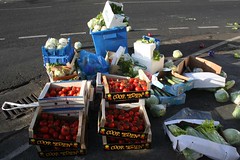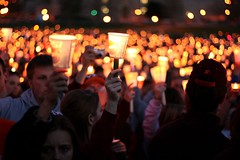Thursday, May 10, 2007
Monday, May 07, 2007
Saturday, May 05, 2007
Sari catching sensor??
Copes well with flooded streets? So now we don't have to care if oceans rise due to global warming. :D
Thursday, May 03, 2007
France on Times Topics
Wednesday, April 25, 2007
Want more in Google's more links?
Tuesday, April 24, 2007
Job Tips and Five Years
Thursday, April 19, 2007
No one deserves a tragedy
Nikki Giovanni's Convocation address:
We are Virginia Tech.
We do not understand this tragedy. We know we did nothing to deserve it, but neither does a child in Africa dying of AIDS, neither do the invisible children walking the night away to avoid being captured by the rogue army, neither does the baby elephant watching his community being devastated for ivory, neither does the Mexican child looking for fresh water, neither does the Appalachian infant killed in the middle of the night in his crib in the home his father built with his own hands being run over by a boulder because the land was destabilized. No one deserves a tragedy.
We are Virginia Tech.
On a different note, the gunman was initially identified as "foreign", then "Asian", then "South Korean" (who could barely speak English??!!!). Washington Post identified him as a "Fairfax man" in a couple of posts. The majority of press now just says "the gunman". KQED's Pacific time has an interesting story on the reactions when he was pronounced "Asian".
Thursday, April 12, 2007
Scattered pearls on a DC metro
Guess what!! Just seven ppl stop to listen and appreciate the music and only ONE person recognizes that it is Mr. Joshua Bell. Fascinating story!!
Original story by post: http://www.washingtonpost.com/wp-dyn/content/article/2007/04/04/AR2007040401721.html?hpid=topnews
NPR interview with Mr. Bell: http://www.npr.org/templates/story/story.php?storyId=9521098
I vividly remember one such embarrassment. When Violin Maestro TN Krishnan came to Pilani in 1999, there was expected to be a crowd. But there were around 20 people and barely occupied the first row in the huge auditorium. For the Immanuel Kants of the group, here an pseudo-epistemological question, which is more embarrassing?
But I am sure the Bell story would have taken a different turn if he played on a Saturday afternoon in Union Square, NY or SF.
Tuesday, April 03, 2007
Splitter Hack
Sunday, March 18, 2007
Shoes from Japan and trousers from England?
There was a really popular patriotic song by Raj Kapoor which goes something like this:
Mera Joota hai Japani
Yeh Patloon Inglistani
Sar pe lal topi rusi
Phir bhi dil hai hindustani
(My shoes are Japanese
The pants are from England
The red hat on my head is Russian
But even then, my heart is Indian)
In an ironic twist of India's fate, shoes and trousers now seem to be made in India and the heart...not so much as the younger generations try to break free from the 'meaningless' shackles of the traditional Indian society !!
Mira Nair's Namesake
Mira Nair makes a clear point. People think and feel almost the same things, but some cultures choose to say some things out, while others say some other things. But the movie is not just about cultural similarities nor is it entirely about identity crisis as reflected in the title Namesake. The main character, Gogol (played by Kal Penn) is named after the Russian writer Nikolai Gogol. In a sea of white kids, Gogol finds his name so uncool that he changes his name to Nikhil.
So what's the rest of movie about? Most of the latter half was about Closure. The characters come to terms with a death and the guilt of not being around. Aashima grows stronger and Gogol finally comes to accept his name and the Russian author.
With Sholapur bedsheets on the beds of newly arrived and a gradual change in English accents of immigrants, Mira Nair makes 3 decades of time flow by smoothly. She makes the movie for Fox Searchlight but subtitles only Bengali and NOT Indian English. Nair has a flair when it comes to filming lovemaking. Scenes in all her earlier work, especially Mississippi Masala, have a strong woman-director signature. She continues the tradition and takes it a step further with the most honest lovemaking scene in a saree ever to be filmed.
With quite a few insider jokes, some US-thru-immigrant-eyes jokes, wonderful performances by all the cast, good music by Nitin Sahwney and some INTENSELY personal moments, Mira Nair's Namesake will linger in your mind for a while.
Monday, March 12, 2007
Funny Reject Letter
After careful review of admissions from different schools, I regret to inform you that I will not be accepting admission from your school. Please note that it has got nothing to do with your school but merely a space-time limitation of Einsteinian Physics which forbids me from staying at more than one place at the same time.
All the Best with your current and future students
Thanks
XXXX-XXXX-XXXX-XXXX
Sunday, March 11, 2007
Sell by mm/dd
 BTFM dumped food 1
BTFM dumped food 1Originally uploaded by M.Eugenia.
According to an estimate shown on BBC's One Planet, a third of all food in the developed world gets dumped. A lot of food goes waste in the developing world as well. But the reasons for wastage are vastly different. In the developing world, a lot of the wastage is because of inefficiencies in supply chain, inadequate refrigeration facilities etc, where as in the developed world, a large chunk of the wastage is at the household level. For instance, in UK alone, out of US$ 38 billion worth of annual food wastage, the retail-store sell-by expiry contribution was a mere $3.54 billion !! They clearly got their act together.
As you might have guessed, information can play an enormous role in minimizing waste in both worlds. A little e-chart on the refrigerator that keeps a tab on expiring foods can be an approach. Another approach could be letting people know the amount of energy and water spent in growing all that food. For example, fruits take water 100+ times their weight. A lot of developed countries import food (as shown in this map) which means wastage of water at places where its usually scarce.
One key insight from both IS210 and IS243 has been: "The key to supply chain optimization isn't moving things faster according to plans, it is moving things smarter according to actual demand" (which implies its more about managing information than actual physical goods). Corporates in developed world have realized and enormously benefited from this for a long time. Besides not seeing any benefit from this realization, developing world poses another significant problem. Its really hard to see an end-to-end system where there are a million different vendors and farmers both of whom have little holdings and revenues. It's a challenging problem and pay-offs can be as large as significant elimination of global poverty and hunger.
Friday, February 16, 2007
Less of Pakistan, more of China
This is might be pretty obvious but let me just say it out for the record: "India and Pakistan" seems to be occurring less and less in news and "India and China" is on a slow rise (notice the little spike somewhere mid-2006). But hey it takes a little bomb blast or a gun fire in the border to get the "india and pakistan" spike up, so just keep your fingers crossed hoping nothing abnormal happens.
Wednesday, February 07, 2007
Enough Coverage?
Steve Herrmann of BBC talks about BBC and its place in Rising India. He also asks how they differ from/compare to the local media channels in India.
Here at UC Berkeley, there is a little tradition of having the main pages of selected daily newspapers on a library wall. There are six slots, two of which are taken: The Washington Post, The Guardian. Two of the other four slots are most often (9/10 times) taken by the Jerusalem Post and the Arab News. The final two slots are more generic, usually taken by South China Morning Post, The Asahi Shimbun, The New Anatolian, Irish Independent and rarely (i mean rarely) there is The Times of India. So everyday when I look at that wall, I tell myself “Well, Middle East is definitely important. But is it worth 9/10 times when the two giant countries China and India are rising ??”. I get a similar feeling when I watch BBC in India. BBC is of course outstanding in its coverage, analysis etc. etc…but does it cover enough of India when it does Indian programming? Most of the times, it is far less when compared to NDTV and its ilk.
Sunday, January 21, 2007
Life, Liberty and the Pursuit of Happiness
The movie inspired by real life rags-to-riches story of Chris Gardner, a self-made millionaire, set in the early 80s. One of the first scenes of the movie shows Reagan talking about years of economic downturn on one of those old TVs with a knob. Chris struggles to sell a portable version of a hard bone density scanner (or whatever) which btw looks like a 80s portable computer given that the movie is set in San Francisco. Anywho, he has a really really hard time paying the bills and house his kid.
Chris has a thing for neatly dividing his existence into phases like "being stupid", "running across SF" (to catch up with 101 things trying to pull apart his already below the poverty line existence)* etc. As the movie detailedly fleshes out the abject poverty of a black man, it can get very depressing and even tear-jerking. But on the upside, smiles, smarts and most of all the fatherly love and the warmth between him and his son keep you hoping for that concluding phase of brief period of happyness.
The movie avoids saccharine sentiment but at the same time takes two full hours to sketch out Chris Gardner's exhaustive runs up and down the hills of both San Francisco and his own life.
The movie for the most part concentrates on details of pursuit of riches (or in this case, riches for bare-minimum existence), but the movie has its greatest justification for the title, when in the end Chris realizes part of his what-i-can-be-dreams and starts walking away from constant disappointments with himself.
* Being poor has a huge price. A study about price comparisons in Dharvi (the biggest slum of Bombay and Asia) and a close-by well to-do neighborhood has concluded that clean water is about 30 times costlier in Dharvi.
Thursday, December 14, 2006
Keshava guy again
I am 'Keshava' guy in this latest episode of a popular desi podcast called "Desi Dilemmas". The producer of the podcast reads out one of my earlier post on Hindu temples in United States. Tell me what you think
Monday, December 04, 2006
Amazon's unspun
Amazon has a new service called unspun that crowd sources compilation of various best lists. The idea is get people vote and sort the different categories by votes. Its ajaxified, built using ruby on rails and asks for a login before it lets you vote. I tried to find out if the number of votes has any correlation with the size of its wikipedia article (if thats any measure of popularity).

(Update: Replaced the table with the graph and moved the table to 'more')
Clearly, the wikipedia-size curve has spikes like Word, Openoffice, Corel and valleys like notepad and Ultraedit. On the other hand, if the table is sorted by wikipedia-size, textmate is a prominent spike on the vote curve. Well, its the same crowd, does it make sense for these to smoothen out? May be, yes.
There's probably some alpha-beta user bias in the voting at this point as seen in this favorite subject list or Patrick Stewart (above Marlon Brando) in this list. But that should even out as this service becomes popular. While its easy to normalize and give them a letter grade, I wonder how a letter grade approach would work as opposed to ranking them. I find it hard to rank Marlon Brando, Robert De Niro, Al Pacino, Jack Nicholson, Tom Hanks, Kevin Spacey, Dustin Hoffman in a particular order. Now bring in non-Hollywood actors like Sivaji Ganesan, Amitabh Bachchan, Kamal Hassan or Toshiro Mifune. It only gets harder. I find it lot easier for me to give them a letter grade. Grading may be less mentally taxing than ranking and hence increase participation. On the other hand, grading doesn't pump up enough adrenalin for most users. Its probably not enough incentive to campaign for a better rank of their favorite item. Anyways, keep exploring and comment some of the interesting lists you stumble upon.
Tuesday, November 28, 2006
Zune and Network effects
What would be really interesting is if Apple adds Wi-Fi to iPod and both Apple and Microsoft allow to share music across networks which can lead to some awesome discoveries (but at the same time it would be one long horrendous nightmare for the music industry). On the other hand, what would be terrible is if apple adds Wi-Fi and iPod and Zune dont talk to each other !! That would be like owning a phone but cannot make calls to 70% of the world (or <1%>
Tuesday, November 14, 2006
Can temples be more retrograde?
Temples here have a similar story. Climate and Air-conditioning make them close walled. Temples are THE places of gathering for Desis, grocery stores being a close-second. Some guy said he is looking for a job and put up his resume on a temple notice board in San Jose! From 'Camry for sale' to furniture to music classes to India tickets to SP Balasubramanyam's benefit show to a local desi DJ party .....everything ends up on a temple notice board. Temples have been embracing enough in these instances.
But why do they have to look exactly like the ones built by Raja Raja Chola or Krishna Deva Raya?? Why do they have to the same ornamentation on walls and the roof invented centuries ago? The only innovation I can appreciate is...coloring the ornamentation... as done on the outer gopurams of the Meenakshi temple in Madurai even though it may sound a little cheesy and non-traditional (non-vaidika) for many brahmins. Oh, wait! How can I forget this great innovation? The Saraswathi temple in Pilani (home to BITS Pilani) is modelled after one of those exotic Khajuraho temples. But the high point is when you notice the busts of Lincoln, Ramanujan, Vivekananda, Paramahamsa, Pasteur, Einstein, Tagore and other 'kids of Saraswathi' on its white marble walls. Thats some re-interpretation of Saraswathi, I thought. GD Birla was truly a visionary. (Well, I've to admit that I went to school there. But even with out those allegiances, I' would admit that Saraswathi Mandir is quite something).
Now, here is a country that is the home to some of the greatest modern architects on the planet: Lloyd Wright, Frank Gehry, Louis Kahn and Maya Linn ( I choose these people in this context... as these are the guys who have an outstanding sense of blending with nature, flowing shapes, natural ventilation and a sense of time). The 'model minority' of the nation with all its wealth, advanced degrees and progressiveness goes to temples frozen in 15th century! The low point was the Swaminarayan temple in Chicago. Tonnes of money were spent on the temple, tonnes of marble was mined from God knows where. There is an elaborate tour of 'Sanatana Dharma' along the entrance. But I felt extremely claustrophobic when I stepped into the actual temple. Its like a dungeon with little sun light coming in. They only got more money to spend on 'disco lighting'. I couldnt avoid drawing comparisons to the cave paintings of France. The only difference, the visitors here are not high on narcotics.
The other extreme was a small time temple in Artesia, near Los Angeles. A church in a neighborhood which recently became 'Little India' ...was converted to a temple. The temple didnt have any inner sanctum and a formal priest. It didnt have a shoe stand, it had a coat closet and rows of seating. But was I comfortable with the whole thing? Not completely. I didn't find it original enough. It was too practical ( :D ). It was too much of change. It was not building on any of the existing 'culture' nurtured and matured through centuries of time.
But I believe there is a middle ground. I believe there has to be an evolution. An evolution from those 15th century architectural approaches to something more modern but at the same time retaining the core philosophy of the traditional approach. Chola's Brihadeeswaralaaya is state-of-the-art because, at that time it was higher than anything around it. It took some innovative engineering techniques to build temples using massive amounts of rock. It held people in awe. I am not sure if taking a 15th century approach to constructing a temple today has the same effect.
The mere fact that these temples are in the United States, somehow raises my expectations a lot. In this country, there can be a Vegas kind of extravagance, a bible belt kind of conservatism but there will be and should be a religious equivalent of Maya Lin's contemplative Vietnam War Memorial.


